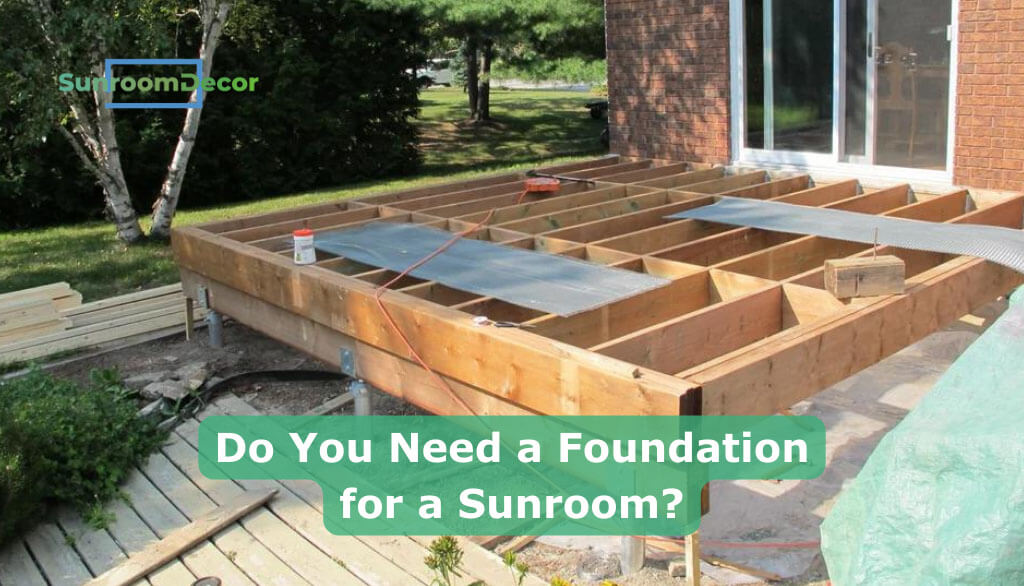Sunrooms are a popular home addition that can provide a beautiful space to relax and enjoy the outdoors while still being protected from the elements. One question that often arises when considering a sunroom is whether or not it requires a foundation.
The short answer is yes, most sunrooms do require a foundation. A solid foundation is essential for any structure. This is because a sunroom is considered an extension of your home, and as such, it needs to meet the same building codes and regulations as the rest of your house. This includes having a proper foundation to ensure that the structure is stable and secure.

The Importance of a Foundation for a Sunroom
When planning to build a sunroom, one of the critical elements that homeowners must consider is the foundation. A foundation serves as the base or support for any structure, ensuring that it stays level, stable, and secure. When it comes to sunrooms, a proper foundation is essential to support the weight of the structure and protect it from damage caused by soil erosion, settlement, and other external factors.
A foundation is a structural element that supports the weight of a building or other structure and transmits it to the underlying soil or rock. The primary purpose of a foundation is to ensure that the structure remains stable and secure, preventing it from sinking, shifting, or collapsing. A foundation typically consists of concrete footings or piers that are reinforced with steel and extend below the frost line to provide maximum stability.
A sunroom is a structure that is primarily made of glass and designed to allow natural light and outdoor views while providing shelter from the elements. While a sunroom may seem like a simple addition to a home, it’s still essential to build it on a solid foundation. Here are some reasons why a foundation is critical for a sunroom:
- Support and Stability: A sunroom’s weight can be significant, especially when it’s filled with furniture, plants, and other decorations. A proper foundation ensures that the sunroom can support this weight and remain stable, preventing it from sinking or shifting over time.
- Protection from Moisture: Moisture can damage a sunroom’s floor and walls, leading to rot, mold, and other problems. A foundation elevates the sunroom above the ground, keeping it dry and preventing moisture from seeping into the structure.
- Prevent Soil Erosion: Over time, soil erosion can cause a sunroom to sink or shift, leading to costly repairs. A foundation provides a stable base that resists soil erosion and helps to keep the sunroom level.
Types of Foundations for a Sunroom
The foundation is the base that supports the weight of the sunroom and helps to ensure it remains stable and secure over time. There are several types of foundations to choose from, each with its own advantages and disadvantages.
Concrete slab
This involves pouring a flat, level slab of concrete on the ground, which serves as the base for the sunroom. Concrete slabs are relatively easy and quick to install, and they provide a solid, stable base for the sunroom. They are also generally less expensive than other types of foundations. However, one disadvantage of a concrete slab is that it may crack over time, particularly if the ground underneath it shifts or settles.
Pier and beam
This involves placing concrete piers or columns in the ground, and then building a wooden frame on top of them to support the sunroom. Pier and beam foundations are generally more expensive than concrete slabs, but they offer some advantages. For one thing, they can be adjusted to accommodate uneven terrain, so they may be a good choice if your property has hills or other irregularities. They can also provide good ventilation and insulation, which can help keep your sunroom comfortable year-round.
Full basements
This involves excavating a hole in the ground and pouring a concrete foundation for the sunroom to sit on. Basements are generally the most expensive type of foundation, but they offer some unique advantages. For one thing, they provide a lot of additional storage space, which can be useful for homeowners who are short on space. Basements also provide excellent insulation and protection against the elements, which can help keep your sunroom comfortable and dry.
How Local Building Codes Affect Sunroom Foundation Requirements
When building a sunroom, it’s important to consider the local building codes and regulations in your area, especially when it comes to the foundation. Building codes are put in place to ensure the safety and structural integrity of buildings, and failing to comply with them can result in fines, legal issues, and even safety hazards.
One of the main factors that building codes consider when it comes to sunroom foundations is the soil condition. The type of soil in your area can have a significant impact on the type of foundation that’s needed to support the weight of the sunroom and prevent it from sinking or shifting over time. For instance, if the soil is prone to shifting or settling, a more stable and durable foundation may be required.
Another factor that building codes may consider is the climate and seismic activity in your area. If you live in an area that’s prone to hurricanes, earthquakes, or other natural disasters, the foundation requirements may be stricter to ensure that the sunroom can withstand the forces of nature.
So, how can homeowners find out about the specific building code requirements for sunroom foundations in their area? The best place to start is by contacting your local building department or zoning board. They can provide you with information on the specific codes and regulations that apply to your property, including the foundation requirements for sunrooms.
It’s also a good idea to work with a licensed and experienced contractor who is familiar with the local building codes and can ensure that your sunroom is built to code. They can help you determine the most appropriate foundation type for your specific property and provide guidance on how to comply with the building codes.
The Importance of Site Preparation for Sunroom Foundation Installation
When planning to install a sunroom, it’s essential to consider the site preparation process, as it can impact the foundation’s stability and longevity. Proper site preparation can prevent future foundation issues, such as sinking or shifting.
Before installing a sunroom foundation, it’s essential to remove any existing structures on the site. This process ensures that the new foundation will sit on undisturbed soil, preventing future foundation issues. Next, the site must be graded to ensure that the foundation will be level. Uneven ground can cause the foundation to shift over time, leading to structural issues in the sunroom.
Additionally, it’s crucial to address any drainage or water issues on the site before installing the foundation. Poor drainage can cause water to pool around the foundation, leading to erosion and foundation damage. Homeowners should consider adding a French drain or other drainage solutions to prevent water buildup around the sunroom foundation.
It’s important to note that different soil types may require different site preparation measures. For example, soil with a high clay content may require more extensive site preparation, such as adding gravel or other drainage solutions.
Proper site preparation is crucial for a sunroom foundation’s stability and longevity. Improper site preparation can lead to foundation issues down the road, such as sinking or shifting. Homeowners should consult with a professional contractor to ensure that the site preparation process is done correctly.
DIY vs. Professional Installation: What’s the Best Option for Your Sunroom Foundation?
DIY Installation
If you’re a skilled DIYer with experience in construction and concrete work, you may be able to install a sunroom foundation yourself. However, keep in mind that this is a major undertaking that requires a significant amount of time, effort, and expertise. You’ll need to:
- Obtain the necessary permits and approvals from your local building department.
- Clear and level the site to ensure a stable base.
- Dig and pour the footings, ensuring they’re level and in compliance with local codes.
- Install the reinforcing steel and pour the concrete slab or pier and beam foundation.
- Allow the concrete to cure properly before building the sunroom on top.
If any of these steps are done incorrectly, it can compromise the stability and safety of your sunroom foundation. Additionally, DIY installation may not be the best option if you don’t have access to the necessary tools and equipment or are not comfortable working with heavy materials.
Professional Installation
Hiring a professional contractor to install your sunroom foundation may be a more costly option, but it can save you time, stress, and potential liabilities. A reputable contractor will:
- Have the necessary licenses and insurance to operate in your area.
- Provide a detailed estimate and timeline for the project.
- Handle all the necessary permits and inspections.
- Use high-quality materials and equipment to ensure a stable foundation.
- Offer a warranty or guarantee for their workmanship.
By hiring a professional, you can have peace of mind knowing that your sunroom foundation is built to code and will last for years to come.
Cost and ROI Considerations
Cost of Installing a Sunroom Foundation
The cost of installing a sunroom foundation can vary widely depending on factors such as the type of foundation, the size of the sunroom, and the local labor and material costs. In general, a concrete slab foundation is the most affordable option, while a full basement foundation can be the most expensive.
According to HomeAdvisor, the national average cost to install a concrete slab foundation for a sunroom is around $4,000-$12,000, while a pier and beam foundation can range from $5,000-$15,000, and a full basement foundation can cost upwards of $50,000 or more. Keep in mind that these are just estimates, and your actual costs may be higher or lower depending on your specific situation.
ROI of Adding a Sunroom to Your Home
While the initial cost of adding a sunroom to your home may seem daunting, the good news is that this type of home addition can have a positive impact on your home’s value and overall livability. According to Remodeling Magazine’s Cost vs. Value report, a midrange sunroom addition can recoup an average of 51.7% of its cost in resale value.
In addition to the potential resale value boost, a sunroom can also provide other benefits that can increase your overall ROI. For example, it can add extra living space, provide a relaxing space to enjoy the outdoors while still being protected from the elements, and potentially improve energy efficiency by allowing more natural light into your home.
Maintaining Your Sunroom Foundation
When you invest in a sunroom, you want it to last for many years to come. While a sturdy foundation is the first step in achieving this goal, it’s also important to keep up with ongoing maintenance and repairs. Here are some tips and tricks for keeping your sunroom foundation in top condition.
- Keep the area around the foundation clean and clear. Regularly sweep away debris and trim back any nearby plants or trees to prevent roots from growing into the foundation.
- Check for water damage. If you notice any water pooling or seeping into the foundation, take action immediately to address the issue. This could involve adding drainage, sealing cracks or gaps, or installing a sump pump.
- Inspect for pests. Insects and rodents can cause damage to your sunroom foundation, so be on the lookout for signs of infestation such as droppings or chewed wood. Take steps to eliminate the pests and prevent future entry.
- Keep an eye out for cracks or shifting. If you notice any cracks in the foundation or signs that it’s shifted, such as uneven floors or walls, contact a professional for an assessment. Early intervention can prevent more serious damage down the road.
- Schedule regular inspections. Consider hiring a professional to inspect your sunroom foundation on an annual basis. They can identify any potential issues early and provide recommendations for maintenance or repairs.
FAQs
What kind of foundation is needed for a sunroom?
The type of foundation needed for a sunroom depends on various factors such as soil conditions, climate, and local building codes. Common types of foundations used for sunrooms include concrete slab, pier and beam, and full basement. It’s important to consult with a professional contractor and comply with local regulations before deciding on a foundation type.
Do you need a foundation for a 4 season sunroom?
Yes, a foundation is typically required for a 4-season sunroom, as it is a permanent structure that needs to be anchored securely to the ground to prevent shifting or settling over time. The specific type of foundation needed will depend on factors such as the soil conditions, local building codes, and the design of the sunroom.
Do you need a foundation for a 3 season room?
Yes, a foundation is typically required for a 3 season room. The type of foundation required may depend on local building codes and site conditions.
How deep is the foundation for a sunroom?
The depth of the foundation for a sunroom can vary depending on factors such as local building codes, soil conditions, and the weight of the structure. In general, it is recommended to have a foundation that extends below the frost line to prevent shifting and settling over time. This can typically range from 18 inches to several feet deep.
How to build a sunroom foundation?
Building a sunroom foundation involves several steps such as selecting the appropriate foundation type, preparing the site, pouring the foundation, and ensuring proper drainage. It’s important to follow local building codes and consult with professionals to ensure a successful installation. The specific process and materials required will depend on the type of foundation selected and the site conditions.
Conclusion
Building a foundation for a sunroom is essential to ensure its stability and durability over time. The type of foundation required depends on various factors such as local building codes, soil conditions, and climate. Homeowners should also consider the cost, ROI, and ongoing maintenance and repair requirements before deciding to install a sunroom.
While it may be tempting to save money by attempting a DIY installation, it’s often best to hire a professional contractor who has the necessary skills and tools to ensure a successful and safe installation. With proper site preparation, regular maintenance, and timely repairs, a sunroom can provide homeowners with a comfortable and enjoyable living space for many years to come.



